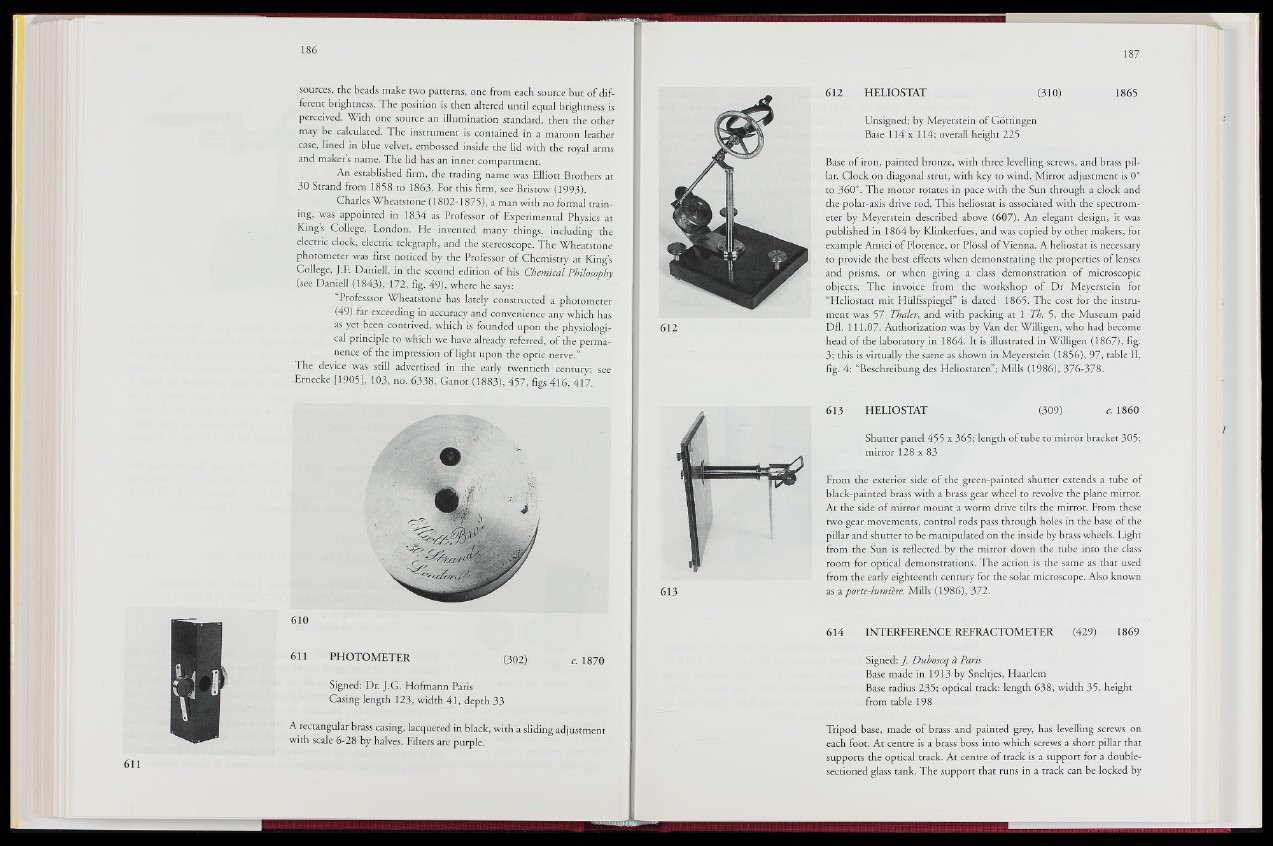
sources, the beads make two patterns, one from each source but of different
brightness. The position is then altered until equal brightness is
perceived. With one source an illumination standard, then the other
may be calculated. The instrument is contained in a maroon leather
case, lined in blue velvet, embossed inside the lid with the royal arms
and maker s name. The lid has an inner compartment.
An established firm, the trading name was Elliott Brothers at
30 Strand from 1858 to 1863. For this firm, see Bristow (1993).
Charles Wheatstone (1802-1875), a man with no formal training,
was appointed in 1834 as Professor of Experimental Physics at
Kings College, London. He invented many things, including the
electric clock, electric telegraph, and the stereoscope. The Wheatstone
photometer was first noticed by the Professor of Chemistry at Kings
College, J.F. Daniell, in the second edition of his Chemical Philosophy
(see Daniell (1843), 172, fig. 49), where he says:
Professsor Wheatstone has lately constructed a photometer
(49) far exceeding in accuracy and convenience any which has
as yet been contrived, which is founded upon the physiological
principle to which we have already referred, of the permanence
of the impression of light upon the optic nerve.”
The device was still advertised in the early twentieth century; see
Ernecke [1905], 103, no. 6338. Ganot (1883), 457, figs 416, 417.
610
611 PHOTOMETER (302) r. 1870
Signed: Dr. J.G. Hofmann Paris
Casing length 123, width 41, depth 33
A rectangular brass casing, lacquered in black, with a sliding adjustment
with scale 6-28 by halves. Filters are purple.
612 HELIOSTAT (310) 1865
Unsigned; by Meyerstein of Gottingen
Base 114 x 114; overall height 225
Base of iron, painted bronze, with three levelling screws, and brass pillar.
Clock on diagonal strut, with key to wind. Mirror adjustment is 0°
to 360°. The motor rotates in pace with the Sun through a clock and
the polar-axis drive rod. This heliostat is associated with the spectrometer
by Meyerstein described above (607). An elegant design, it was
published in 1864 by Klinkerfues, and was copied by other makers, for
example Amici of Florence, or Plossl of Vienna. A heliostat is necessary
to provide the best effects when demonstrating the properties of lenses
and prisms, or when giving a class demonstration of microscopic
objects. The invoice from the workshop of Dr Meyerstein for
“Heliostatt mit Hiilfsspiegel” is dated 1865. The cost for the instrument
was 57 Thaler, and with packing at 1 Th. 5, the Museum paid
612 Dfl. 111.07. Authorization was by Van der Willigen, who had become
head of the laboratory in 1864. It is illustrated in Willigen (1867), fig.
3; this is virtually the same as shown in Meyerstein (1856), 97, table II,
fig. 4: “Beschreibung des Heliostaten”; Mills (1986), 376-378.
613 HELIOSTAT (309) c. 1860
Shutter panel 455 x 365; length of tube to mirror bracket 305;
mirror 128 x 83
From the exterior side of the green-painted shutter extends a tube of
black-painted brass with a brass gear wheel to revolve the plane mirror.
At the side of mirror mount a worm drive tilts the mirror. From these
two gear movements, control rods pass through holes in the base of the
pillar and shutter to be manipulated on the inside by brass wheels. Light
from the Sun is reflected by the mirror down the tube into the class
room for optical demonstrations. The action is the same as that used
from the early eighteenth century for the solar microscope. Also known
as a porte-lumière. Mills (1986), 372.
614 INTERFERENCE REFRACTOMETER (429) 1869
Signed: ]. Duboscq a Paris
Base made in 1913 by Sneltjes, Haarlem
Base radius 235; optical track: length 638, width 35, height
from table 198
Tripod base, made of brass and painted grey, has levelling screws on
each foot. At centre is a brass boss into which screws a short pillar that
supports the optical track. At centre of track is a support for a doublesectioned
glass tank. The support that runs in a track can be locked by